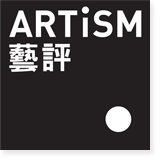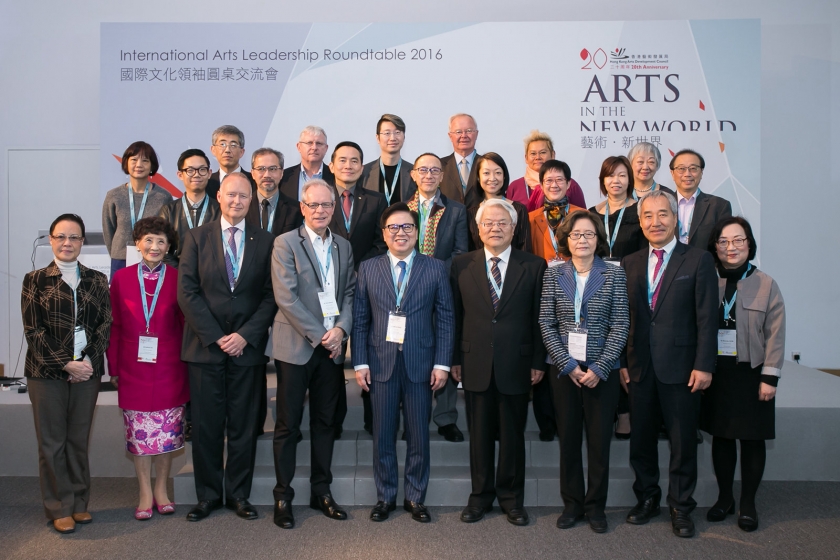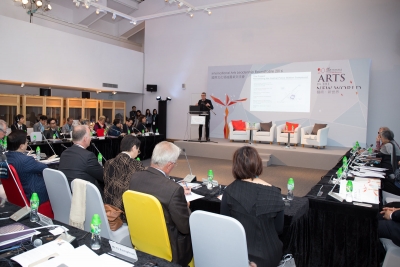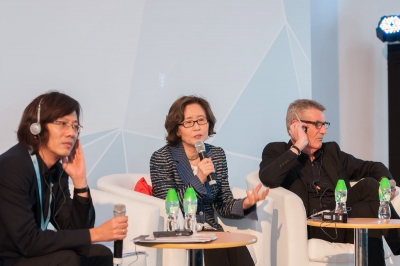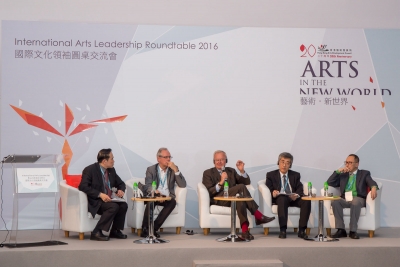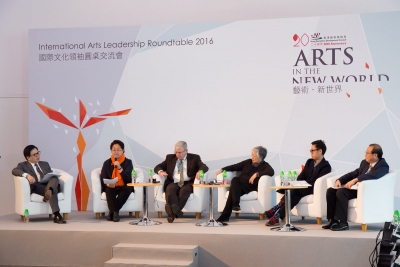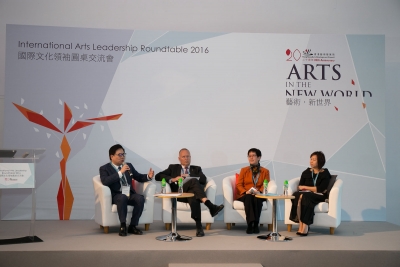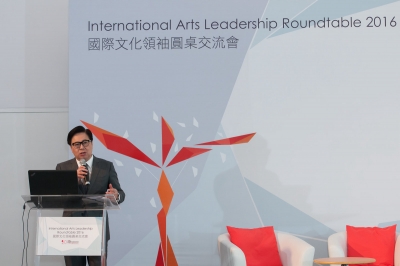Strategic planning of arts development is a burgeoning field around the world along with being a continuing subject of debate. Today, art venues designed by ‘starchitects’ have provided an exciting array of spaces to experience art, though they also reflect a trend toward an increasing homogenization of the cultural experience. In the context of communication technologies in everyday life, new media has enabled instant social interactions that easily cross borders, which brings into question the art world’s approach to presentation, collecting, and promotion. In the midst of a fundamental shift in arts development that is emerging among the set relationships between creativity, knowledge, capitalism, and innovative technologies, the question becomes: does the brick-and-mortar institution still have the ability to remain the main focus of art and culture in the 21st century?
On 29 February to 1 March, 2016, the Hong Kong Arts Development Council organized the second edition of the International Arts Leadership Roundtable, which was held two years ago with the mission of creating the first-of-its-kind conference in Asia that involves notable international delegates. As an invited speaker who was asked to reflect on the local significance of these issues and to provide suggestions that might contribute to the global context, I attempted to respond to the current trends and challenges of arts development.
Younger generation and new technologies
A cover story of TIME Magazine issued in 1970 was titled, “How to educate your parents”, which highlighted the difference in values and attitudes between pre-World War II adults and the baby boomers. Yet another cover story in 2013 was titled, “The me me me generation: Why millennials will save us all’. This article suggests that the baby boomer generation is losing hold on the millennials. In the time when the former drainpipe-trousered and net-stockinged youths are moving closer to retirement, a new kind of generation gap has emerged.
Most baby boomers grew up in the time when phones and computers were separate entities that had nothing to do with one another. Thanks to Steve Jobs’s attempt to embed an entire desktop operating system inside a cell phone, the millennials from an early age use digital devices that penetrate every aspect of their day to day existence. Apart from the fact that the millennials tend to cope with technologies more quickly than previous generations, they seek a broader range of activities that are conjointly integrated through social media, an existence that is fused with a mixture of on and off line interactions.
We know the millennials have a different mindset from their predecessors, but how does it relate to the art world? While some of the millennials only use smartphones for simple tasks like taking selfies, the remaining are changing the rules of the game in every aspect of our society, which necessarily includes art and how it is presented and consumed.
In 2014, a photo which depicts a group of teenagers checking their cell phones while sitting next to Rembrandt’s Night Watch at the Rijksmuseum went viral on the internet. The photo earned mixed reactions from the viewers as some criticized that the teenagers were disrespectful to Rembrandt, while others thought it was amusing. The viral photo caught the Rijksmuseum’s attention as to whether the museum is doing a good job in stimulating teenager’s interest in art. Although the Rijksmuseum hasn’t banned the use of camera, since then, a big banner of a crossed-out camera was prominently displayed at its main entrance, followed by a campaign called “#Startdrawing”, which encourages teenagers to make sketches rather than using their camera while visiting the museum.
Discussions concerning how visitors should behave in museums are not new. A few years before the Rijksmuseum viral photo when smartphones were not yet so popular, a New York Times article titled, “At Louvre, many stop to snap but few stay to focus”, was published to illustrate the trend of visitors who tended to snap photos of the art in that museum. The writer, Michael Kimmelman, who is the New York Times' longtime chief art critic, claims that cameras had officially replaced sketching by the end of the last century. If photography has replaced realistic sketching due to its popularity among the museum-goers, is the Rijksmuseum’s campaign a viable strategy in reaching out to the next generation, or is it creating a new barrier between art and the millennial generation?
Without any official ban on visitors taking photos, the crowds of snappers and selfie-makers in front of Mona Lisa is just another day at the Louvre. One may not be surprised that the Lourve has been ranked the ninth most popular places to visit on Facebook in 2015. Social media does consistently influence our lives and for the new generation the biggest attraction of the museum is not viewing and considering the artworks but in building their social currency by using the check-in function. We can also note that the proposal that the museum is the perfect family cultural destination no longer seems to exist. In this era, when family members text each other rather than holding a face to face conversation, will art institutions lose their hold on the younger demographic if their methods of presenting art remains in the same pre-digital mode?
Many art institutions have acknowledged the importance of social media as a key aspect of audience engagement. In recent years, many renowned art institutions have begun to embrace social media and have attempted to incorporate apps and websites into their current activities and marketing campaigns. For example, the Guggenheim Museum has collaborated with YouTube and HP to launch YouTube Play, an online video channel that showcases 25 videos that are made by amateur video makers. The project is considered to be one of the most successful online exhibitions that, since 2010, has attracted over sixty thousands subscribers.
Despite the success of the campaign, one might also ask why would amateur video makers want their videos to be selected by the Guggenheim if they have already had a platform on their own YouTube channels? Indeed, the impact of YouTube Play is tiny compared to any famous YouTuber. To give one example, Michelle Phan, a YouTube personality who began her career at fifteen years old by posting tutorial vlogs about makeup has received more than a billion views, eight million followers, and more than ten thousands daily page-views on YouTube. The popularity of independent YouTubers has posed a dilemma for the art institution’s social media programs and whether they can remain similarly viral in the 21st century.
On the one hand, cultural institution’s relatively poor popularity on social media suggests that art practitioners have a lot to work on, pinpointing that most of these institutions seem to continually overlook the cultural significance of digital technologies. On the other hand, in the age when the artist-as-genius model has expired, how can art institutions maintain the virtuosity of art without losing the potential younger audience, those who are perpetually surrounded by a bottomless sea of entertainment? During the conference, the focus on the younger generation and digital technologies has been a common theme across different panels and speakers. There is a common view that art practitioners need to tackle major technological challenges. Indeed, using social media only as promotional platform is no longer effective in accomplishing institutional goals. So the question becomes one of how to utilize social media to foster greater audience interactions, perhaps the most important unanswered questions of the conference.
From place-making to spatial networking
Besides the considerations of the virtual presence of the art institution, how can these same institutions create a new face-to-face experience for the 21st century audience, which also raises an important question about urban design and the revitalization of the administrative infrastructure.
In recent years, institutional place-making efforts through arts and cultural development have been seen across the globe. Be it in Bilbao or Beijing, arts and culture have become one of the most valuable assets for post-industrial cities. Beyond the flamboyant structures designed by internationally recognized architects, place-making projects also elicit rich discussions about the disappearance of intangible cultures that might be related to the citizen’s sense of place. Whether architecture can serve as a response to an increasing interest in cultural identity is an important debate. Indeed, we are living in an age when creating global links and preserving local context are equally important. Perhaps one of the biggest challenges of globalization is how to create strategies of inter-governmental cooperation for a new form of multiculturalism. Today, governments’ responses to the simultaneous and contradictory demands of globalization and localization is increasingly pertinent. Behind the façade of the slick-looking buildings, what resides in its infrastructure is equally important. Seeing as most institutions today are still griped by19th century organizational structures, the way institutions fundamentally operate also demands reconsideration.
In the economic sector, the explosion of the “startup” culture has fostered new initiatives that reconsider leadership within knowledge economies. New leadership models such as “holacracy”, a governance structure characterized by a diffusion of power among self-organizing groups rather than top-down authority, have been widely adopted by both the for-profit and non-profit organizations in the United States. In the cultural sector, though many art institutions are trying to reform their governance philosophy into a more dynamic and audience-driven approach, labyrinthine bureaucratic practices that have been carried forward from the previous administrative models have hindered the hoped for change of course.
Many speakers at the conference raised questions concerning the art institution’s governance structures, which asked us to consider whether the current administrative process could effectively advance the missions that are set out by different government authorities. For these government authorities, the process of how to streamline the administrative process in a bid to foster innovation from the creative sector is crucial. While a government’s funding system influences a variety of methodologies around artistic creations, the need for urgent action to reconsider the role of art grants and assessment schemes have become more and more evident. In addition, initiating tax cuts for corporations and revamping copyright regulations that reflect the impact of the internet would further propagate the influences of the arts through collaborations and appropriations.
For non-profit institutions, rethinking a board’s structure and altering its management hierarchy is essential to their continuing relevance. While non-profit art institutions increasingly rely on a diverse group of stakeholders, from financial sources to artistic partnerships, how can they maintain and foster an appropriate governance structure that doesn’t overlook the power of collaboration?
All in all, what has been mentioned in the above can be boiled down to the concept of cultural ecology. In a time when big data and global partnership have become the important factors for arts development, practitioners from different fields are required to think about leadership from the perspective of an inter-organizational network. There is a need for leaders to consider and reference co-creative models, a system that preferences the dynamic interplay between private and public and which allows for a more fluid governance.
Decentralized force: Bottom-up power and new ways of community engagement
Apart from technological and infrastructural advances, the past few years have seen a dramatic trend toward the decentralization of social power. Apart from promoting art, promoting constructive interactions among people through art have drawn the attention of different speakers.
Let’s start with the commercial sector. In 2014, business reporter Matthew Wall from the BBC wrote an article, titled, ‘Innovate or die: The stark message for big business.” It was the same year that the Blockbuster Video Entertainment, Inc suspended its DVD rental operations. In 2004, Blockbuster was the biggest movie and video game rental provider in the world, which consisted of 9,000 stores and over 60,000 employees. What happened to Blockbuster is no secret: Netflix has crushed it. Big corporations that have failed to adapt to changing technologies and consumer trends is not a new story. Kodak is a classic example of how new technologies can disrupts traditional ones, rendering a once a groundbreaking photography company bankrupt.
Corporations that are losing their edge are not confined to tech companies. In 2015, the world's largest chain of fast food restaurants, McDonald’s, closed 350 stores in addition to the 350 it had already planned to close. Apart from immediate and pressing conditions such as cash-flow shortages, the reason various 20th century companies are facing difficulty is fundamentally a cultural issue. Why? Because we are living in a culture where social power is becoming decentralized, concomitant with a rise of consciousness concerning community engagement.
In the commercial sector, disruptive technologies have allowed anyone to become a retailer, be it in the hotel or taxi service industries. Airbnb and Uber, which are the best known examples of the “sharing economy”, have invented new forms of individual and collective participation. Apart from being trendy, what has led these companies to succeed is that they offer new ways to rethink the user’s behavior seeing as users not only have basic needs but personal values, ranging from worker welfare, personal health, and environmental issues. While users in this generation are socially conscious, value-driven, and forward-looking, they want to experience a culture emanating from the bottom up which includes the individual’s position in decision making, voting, and contributing to any endeavor.
In the cultural field, the spirit of the sharing economy in tandem with an increasing focus on the power of the individual has also been manifested in the creative industries. One can see thousands of innovative projects being launched on Kickstarter, an online platform that offers a new method for venture funding. One of the most historically significant art fairs, Art Basel, has also initiated its Crowdfunding Initiative platform to support various artistic projects. The platforms that offer the individual the right to choose or participate are particularly prominent, allowing individuals to lead and actively engage in different capacities in various projects.
Using the cases above as examples, there is a continuing need for cultural practitioners to come up new ways to engage the community. The existing modes of community outreach, which are considered through the lens of geography, should consider a new perspective. Community is located everywhere, but is also not exactly located within the global web of symbolic space. In a time when human relationships are more and more connected through new media, art programs must use these technologies to create more powerful connections between people, they must create values that promotes a sense of belonging for audience members who originate from diverse communities.
Conclusion: The future is already here
To conclude, I quote novelist William Ford Gibson’s famous line “The future is already here.” Indeed, what novelists have imagined about the future - how we live, how we drive, how we consume entertainment, how we look at art – has already occurred.
The here and now is like the motherboard of any advanced computing system: If a single chip has failed, the whole motherboard becomes useless. Arts development, together with any other aspect of society, needs to be intrinsically integrated. Using a single disciplinary framework to strategize is not sufficient to lead the arts into the new world. In this article, I have attempted to integrate insights from a range of disciplines into the possible ways that leadership can move forward. The International Arts Leadership Roundtable 2016 was truly a vital platform for delegates from different backgrounds to share, exchange, and debate ideas and proposals. The next phase, the one we have yet to enter, will be a brave new (art) world.
作者簡介: Isaac Leung is a practicing artist, curator and researcher in art and culture. Leung received an Honorary Fellowship of a Bachelor of Fine Arts at the School of the Art Institute of Chicago. His doctorate research specialized in the contemporary Chinese art market. Leung is currently the Chairman of Videotage.
照片提供:香港藝術發展局

